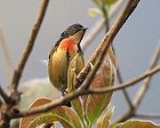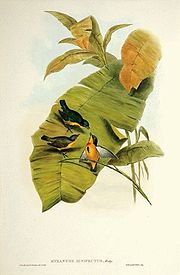
Fire-breasted Flowerpecker
Encyclopedia
The Fire-breasted Flowerpecker (Dicaeum ignipectus) is a species of bird
in the Dicaeidae family found in South and Southeast Asia. Like other flowerpeckers, this tiny bird feeds on fruits and plays an important role in the dispersal of fruiting plants. Unlike many other species in the genus, this species has marked sexual dimorphism
with the male having contrasting upper and lower parts with a distinctive bright orange breast patch. The female is dull coloured.
 Weighing just 7-9 gm and measuring under 7 cm long, it is one of the smallest flowerpeckers. They are usually found at the tops of the trees especially on mistletoes. They have a shrill call given regularly and has been likened to snipping scissors and a staccato tsit.
Weighing just 7-9 gm and measuring under 7 cm long, it is one of the smallest flowerpeckers. They are usually found at the tops of the trees especially on mistletoes. They have a shrill call given regularly and has been likened to snipping scissors and a staccato tsit.
The species was first described by Edward Blyth
in 1843 based on a specimen obtained from Nepal by B H Hodgson
. The name was based Hodgson's manuscripts but published by Blyth. The type specimen said to be deposited at the British Museum is said to be lost, but may exist in the collection of the Asiatic Society museum in Calcutta.
It has been said to be "the smallest bird of India" or "perhaps the smallest":
, Nepal
, Bhutan
, Bangladesh
and extends into Southeast Asia into China, Indonesia, Laos, Thailand, Vietnam, Taiwan, Malaysia and the Philippines. Its natural habitat
s are temperate forest
s, subtropical or tropical moist lowland forests, and subtropical or tropical moist montane forests.
Several populations have been named as subspecies. The nominate ignipectus found along the Himalayas into Southeast Asia on the mainland. The remaining are insular populations and include formosum of Taiwan, luzoniense of Luzon, bonga of Samar and apo of the Negros and Mindanao. The species itself forms a superspecies complex with Dicaeum monticolum, D. celebicum, D. sanguinolentum and D. hirundinaceum which are sometimes all treated as one species. Hybridization with Dicaeum cruentatum has been suggested. Many island forms show patterns of very restricted ranges or micro-endemism and it has been suggested that these be treated with care for conservation planning.
The populations found in the Philippines have males with the underparts similar to D. monticolum while the females have a steel-green gloss on the upperparts unlike the dull green of more northern forms. The Sumatran population beccarii is the most distinct form and differs also from D. sanguinolentum. The males have a steel-green gloss on the upper parts and lack the throat patch while the females have greenish upperparts and lack the red rump.
Throughout its range, the species is found in high mountains above 1000 metres but in China, they may be found during winter at lower altitudes.
In Nainital they are said to breed in June and July. The nest is pendant and purse like, opening on the side towards the top. The nest is thin and felt like, made up of the hairy coverings of stems from mistletoes. The nest is lined with moss and soft grass. Two or three eggs are laid and both sexes incubate and take care of the young.
In Hong Kong, their population is believed to have increased due to maturation of the forests following their restoration. They were first recorded in 1954 but have been seen to breed regularly since 1975.
Bird
Birds are feathered, winged, bipedal, endothermic , egg-laying, vertebrate animals. Around 10,000 living species and 188 families makes them the most speciose class of tetrapod vertebrates. They inhabit ecosystems across the globe, from the Arctic to the Antarctic. Extant birds range in size from...
in the Dicaeidae family found in South and Southeast Asia. Like other flowerpeckers, this tiny bird feeds on fruits and plays an important role in the dispersal of fruiting plants. Unlike many other species in the genus, this species has marked sexual dimorphism
Sexual dimorphism
Sexual dimorphism is a phenotypic difference between males and females of the same species. Examples of such differences include differences in morphology, ornamentation, and behavior.-Examples:-Ornamentation / coloration:...
with the male having contrasting upper and lower parts with a distinctive bright orange breast patch. The female is dull coloured.
Description
This is a small flowerpecker with a small and dark bill. The male has glossy blue-black upperparts. The underside is buffy but a bright red breast patch and starting below it and along the middle is a short black stripe going down till the belly. The female is dark olive above and buff below. The sides are olive and the bill has a pale base.
The species was first described by Edward Blyth
Edward Blyth
Edward Blyth was an English zoologist and pharmacist. He was one of the founders of zoology in India....
in 1843 based on a specimen obtained from Nepal by B H Hodgson
Brian Houghton Hodgson
Brian Houghton Hodgson was an early naturalist and ethnologist working in British India and Nepal where he was an English civil servant. He described many species, especially birds and mammals from the Himalayas, and several birds were named after him by others such as Edward Blyth...
. The name was based Hodgson's manuscripts but published by Blyth. The type specimen said to be deposited at the British Museum is said to be lost, but may exist in the collection of the Asiatic Society museum in Calcutta.
It has been said to be "the smallest bird of India" or "perhaps the smallest":
Distribution
It is found widely distributed along the sub-Himalayan region in IndiaIndia
India , officially the Republic of India , is a country in South Asia. It is the seventh-largest country by geographical area, the second-most populous country with over 1.2 billion people, and the most populous democracy in the world...
, Nepal
Nepal
Nepal , officially the Federal Democratic Republic of Nepal, is a landlocked sovereign state located in South Asia. It is located in the Himalayas and bordered to the north by the People's Republic of China, and to the south, east, and west by the Republic of India...
, Bhutan
Bhutan
Bhutan , officially the Kingdom of Bhutan, is a landlocked state in South Asia, located at the eastern end of the Himalayas and bordered to the south, east and west by the Republic of India and to the north by the People's Republic of China...
, Bangladesh
Bangladesh
Bangladesh , officially the People's Republic of Bangladesh is a sovereign state located in South Asia. It is bordered by India on all sides except for a small border with Burma to the far southeast and by the Bay of Bengal to the south...
and extends into Southeast Asia into China, Indonesia, Laos, Thailand, Vietnam, Taiwan, Malaysia and the Philippines. Its natural habitat
Habitat
* Habitat , a place where a species lives and grows*Human habitat, a place where humans live, work or play** Space habitat, a space station intended as a permanent settlement...
s are temperate forest
Forest
A forest, also referred to as a wood or the woods, is an area with a high density of trees. As with cities, depending where you are in the world, what is considered a forest may vary significantly in size and have various classification according to how and what of the forest is composed...
s, subtropical or tropical moist lowland forests, and subtropical or tropical moist montane forests.
Several populations have been named as subspecies. The nominate ignipectus found along the Himalayas into Southeast Asia on the mainland. The remaining are insular populations and include formosum of Taiwan, luzoniense of Luzon, bonga of Samar and apo of the Negros and Mindanao. The species itself forms a superspecies complex with Dicaeum monticolum, D. celebicum, D. sanguinolentum and D. hirundinaceum which are sometimes all treated as one species. Hybridization with Dicaeum cruentatum has been suggested. Many island forms show patterns of very restricted ranges or micro-endemism and it has been suggested that these be treated with care for conservation planning.
The populations found in the Philippines have males with the underparts similar to D. monticolum while the females have a steel-green gloss on the upperparts unlike the dull green of more northern forms. The Sumatran population beccarii is the most distinct form and differs also from D. sanguinolentum. The males have a steel-green gloss on the upper parts and lack the throat patch while the females have greenish upperparts and lack the red rump.
Throughout its range, the species is found in high mountains above 1000 metres but in China, they may be found during winter at lower altitudes.
Behaviour and ecology
Like many other flowerpeckers, they disperse the seeds of mistletoes. In the Nepal Himalayas, they have been found to important dispersers of Scurrula species.In Nainital they are said to breed in June and July. The nest is pendant and purse like, opening on the side towards the top. The nest is thin and felt like, made up of the hairy coverings of stems from mistletoes. The nest is lined with moss and soft grass. Two or three eggs are laid and both sexes incubate and take care of the young.
In Hong Kong, their population is believed to have increased due to maturation of the forests following their restoration. They were first recorded in 1954 but have been seen to breed regularly since 1975.
Other sources
- Lin, Chen-Wei (2006). Studying breeding bird densities in Meifeng Area by Territory mapping. M Sc. Thesis. National Taiwan University. PDF

